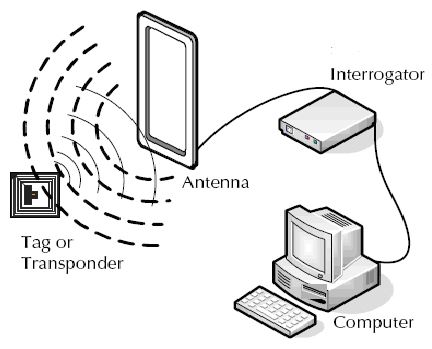Radio Frequency Identification (RFID) is yet another technology which taps the power of radio waves to transmit in a wireless network to uniquely identify an object, person or animal. The Internet of Things or IoT solutions require radio capability to receive and transmit radio waves as a means of communication between the IoT devices as well as with the cloud. RFID can be used with such IoT devices to form a wireless network.
Radio Frequency Identification mainly consists of two parts – an object with an RFID tag and a RFID reader. So, it is the radio waves which carries information in all types of wireless communication. So, it is the radio waves which carries information in all types of wireless communication. Let us have a quick introduction of radio waves.
A radio wave is an electromagnetic frequency component in the spectrum which can be used to transmit/receive information over the air. The radio waves travel at a speed of light and its frequency span a frequency range from 3kHz to 300 GHz. The entire radio frequency band can be divided into three types depending upon their usage.
First, the ‘unlicensed band’ which is used for commercial applications like Wi-Fi or Bluetooth.
Second, the ‘licensed band’ which can only be used after obtaining a proper license from the local regulatory authorities and are used for television and cellular transmission.
The last one is the ‘Forbidden band’ that are used by the government organizations.
Working of RFID
The RFID tags are attached to the asset or inventory which needs to be tracked. These tags can be auto detected without the need of line of sight, and depending upon the radio frequency identification technology its range of detection can be defined and read by the reader.
There are two types of radio frequency identification systems – Active tags and Passive tags.
Passive tags do not have any power source of it own. Rather, they are powered by the electromagnetic energy transmitted from the RFID reader equipment. These can be used for applications like patient tracking in a hospital with the patients tied with the RFID tag, race timing, supply chain, etc.
Active Tags are self-powered by a battery source and are commonly used as ‘beacons’ to track the real time location of assets in a high-speed environment. The active tags provide more reading range than its active counterparts but are also more expensive than them.
The RFID tags basically consists of two main parts- an antenna and a microchip or Integrated Circuit. Whenever a RFID reader or interrogator reads from the passive tag, the passive tag absorbs energy emitted from the electromagnetic energy radiated from the interrogator. The tag’s antenna converts this energy into a radio wave signal that is sent to the read zone. Now, after the tag is read, the antenna again draws in energy from the RF wave and powers the microchip. This chip processes the information and generates a signal back to the RF system. This phenomenon is referred as backscatter. This change in RF wave can be detected by the RF reader which can interpret the required information.

Active tags operate at two main frequencies – 433 MHz and 915 MHz. Usually company prefer the RFID frequency of 433 MHz as their longer wavelength enable them to work better even in non-RF friendly environment like metal and water.
There are two types of active RFID tags available – transponders and beacons.
Transponders use active transponder tag where the reader first sends a signal and then the transponder will send the signal back with appropriate information. This type of tags also conserves battery power when they are out of reading range. We can find these types of systems at toll booth payment systems.
Radio frequency identification systems using active beacon tags keep broadcasting messages every 3-5 seconds. These types of tags are used in oil and gas industry and mining industries as well.
RFID vs Barcodes
Barcodes are manual where the barcode reader has to be placed within the line of sight with the tag in order that the information can be picked up. Whereas, RFID provides an advantage over the manual barcode reading. The RFID can be read by the reader or interrogator even if the object with the tag is visible to the reader or not. The tag can be read even if it is placed inside the carton or a box. Unlike barcodes, radio frequency identification can pick hundreds of data at once whereas barcodes can read only one at a time.
Author
Anupama kumari
M.Tech (VLSI Design and Embedded system)
BS Abdur Rahman University

1 thought on “Radio Frequency Identification (RFID)”